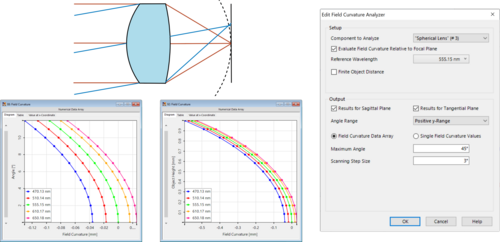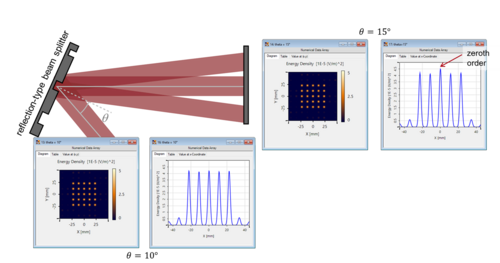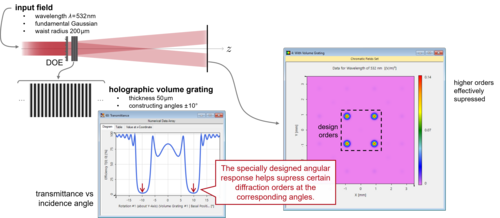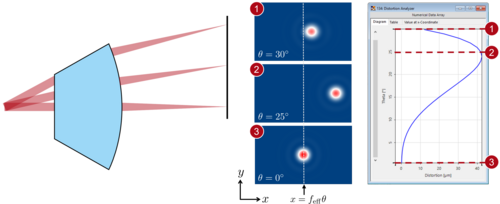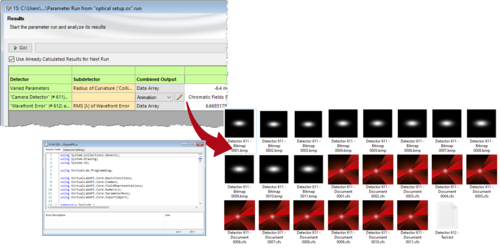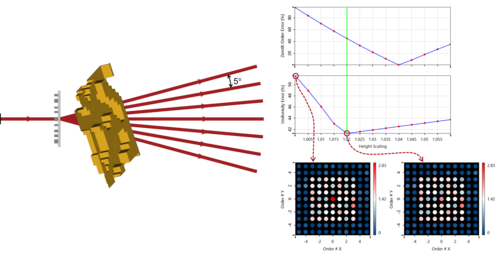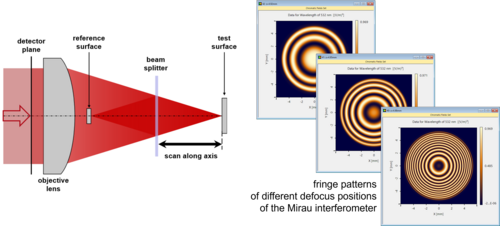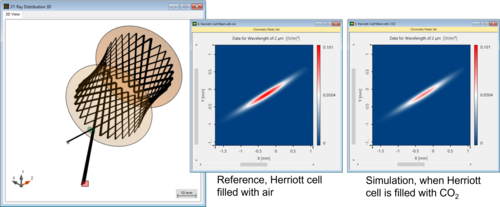What’s new?
Tools for the Analysis of Imaging Errors in Lens Systems
Imaging systems are one of the historical cornerstones of optics, with numerous applications in a wide range of different technologies. Therefore, the performance analysis of lens systems commonly used in imaging is a fundamental task for many optical engineers. To assist the optical engineer in this endeavor, VirtualLab Fusion offers a number of powerful tools.
In this newsletter, we would like to highlight, in particular, the tools for the analysis of field curvature and distortion. These two imaging errors stem from the fact that most detectors operate as plane surfaces, while lenses focus light onto a curve. These aberrations can be investigated with the easy-to-use integrated tools that VirtualLab Fusion puts at your disposal, as shown in the following examples.
Read moreDiffractive Optical Elements & Microstructures
Diffractive optical elements (DOEs) are optical components that use the diffractive properties of engraved microstructures to transform the incoming beam into the desired light distribution, using the periodicity of the structure or lack thereof to create discrete (beam splitters) or continuous patterns (beam shapers, diffusers) respectively. Because the working principle of these components is based on the diffraction of the light by these patterned surfaces, DOE beam shapers and beam splitters can be designed much thinner and lighter than their refractive counterparts, but the small structure sizes make them difficult and resource-intensive to simulate.
In this field, the fast physical optics modeling and design software VirtualLab Fusion offers a family of field solvers based on the Thin Element Approximation (TEA), which allow optical engineers to design systems with this type of devices and to analyze their behavior. As an example, below you can find an investigation of the angular dependence of a reflective diffractive beam splitter, as well as a document offering a deeper look into our diffractive optical element and microstructure components.
Read moreVolume Holographic Gratings
Volume Holographic Gratings (VHGs) are well-known for their high spectral and angular sensitivity combined with adjustable diffraction efficiencies. Hence these gratings are an appropriate tool in optical systems that require accurate spectral and angular filtering. Due to their characteristic three-dimensional and smooth modulation of the refractive index, the modeling can pose numerical challenges, e.g. determining a fine-enough discretization to respect the continuous nature of the refractive-index profile. This can make a simulation of such structures quite demanding computationally, especially when the volume grating is used as just one component in a full, more complex system.
The fast physical optics modeling and design software VirtualLab Fusion enables a fast and accurate simulation of even complex optical systems containing Volume Holographic Gratings by combining specialized solvers for the individual components, such as the Fourier Modal Method in the case of VHGs. Check out the use cases below for an example of an angular-filtering volume grating used in conjunction with a diffractive beam splitter to improve the initial design, as well as an overall introduction on how to configure a volume grating in VirtualLab Fusion.
Read moreF-Theta Scanning Lens
For many applications in the field of high-power laser scanning systems it is important to ensure that off-axis focal spots lie on the focal plane, and not, as happens with regular spherical lenses, along a curved surface. F-theta lenses have been developed with this requirement in mind and are designed to focus incoming collimated beams into a focal spot whose lateral displacement ideally depends linearly on the scan angle.
The fast physical optics and design software VirtualLab Fusion provides several tools that allow the optical engineer to examine the performance of a particular f-theta design. These include the Distortion Analyzer, which calculates the deviation between the actual and desired spot positions, and a scanning source that allows for the simultaneous configuration of a set of field-of-view modes with different incident directions, for a more convenient investigation of the system. Furthermore, the powerful Field Tracing engine gives the user the possibility to investigate the behavior of the focal spots (point spread function) with physical optics, which is capable of uncovering additional effects not taken into account with a pure ray tracer.
Read moreCustomization Tools for Parameter Sweeps
Being able to vary the parameters of an optical system is a key part of the analysis of any setup, in order to better understand how the system will behave in the face of anything from manufacturing errors to potential misalignment of the components. Designing a system that shows robustness when confronted with these unavoidable deviations from the idealized intended design can be just as important as, if not even more than, finding an initial design that perfectly fulfills all the specifications.
With this in mind, the fast physical optics modeling and design software VirtualLab Fusion offers its Parameter Run document: a tool that allows the user to flexibly configure the variation of all system parameters and analyze the corresponding results. In today's newsletter, we would like to show how this tool can improve the optical engineer's workflow with two examples. In the first example, we examine the properties of a collimating lens and automatically export the detector results to a specified file path (for additional post-processing, for instance). In the second example, we use the fully customizable programmable mode of the Parameter Run to realize different random distributions for the variations of the parameters of interest, in order to perform a tolerance analysis of a sawtooth grating.
Read moreDesign and Optimization of non-paraxial Diffractive Beam Splitter
Due to their ability to split a single laser beam into multiple beams in combination with well-defined power ratios, diffractive beam splitters are widely used for applications such as laser material processing and optical metrology. But because of the small feature sizes required for non-paraxial or even high-NA splitting or diffraction angles, the design and optimization of this type of device can be challenging. VirtualLab Fusion provides optical engineers with several tools to assist them in this task.
To illustrate the general workflow, we showcase two examples: In the first example, we employ the Iterative Fourier Transform Algorithm (IFTA) alongside a structure design based on the Thin Element Approximation (TEA) to generate a series of initial designs for a beam splitter, which are then rigorously analyzed and further optimized rigorously with the Fourier Modal Method/Rigorous Coupled Wave Analysis (FMM/RCWA). In order to define a suitable and efficient merit function for that last optimization step, the Programmable Grating Analyzer is applied. The second example covers this part of the process in more detail.
Read moreNonsequential Simulation for Interferometry
Mirau interferometry is a well-known technique that allows the measurement of surfaces with an accuracy of up to one hundredth of the wavelength used. To fully investigate and design such a system, a non-sequential simulation approach is helpful because it automatically incorporates the interference effects that arise from the internal reflections.
Therefore, this week we not only present such a device, but also elaborate on the measurement principle by investigating the interference effects of differently shaped etalons.
Read moreMultipass Absorption Cells for Gas Spectroscopy
In spectroscopy of gases, in order to obtain a sensitive enough measurement of the absorption, it is often required to have long optical path lengths. Multiple-pass cells, where the gas-filled volume is encased between mirrors, are a way of fulfilling this requirement while at the same time controlling beam divergence on the way and preempting the need for extremely large devices. The Herriott cell is one example of this kind of system, characterized by the use of two spherical mirrors with a single off-axis hole drilled into one of them to allow for the entry and exit of the beam. The curvature of the mirrors redirects the beam and controls its divergence.
In today’s newsletter we want to demonstrate the simulation of one such Herriott cell. We have used the Parameter Coupling to link several system parameters together, in order to ensure the correct configuration of the setup while allowing the user to investigate the effect of varying, for instance, the distance between mirrors.
Read more



